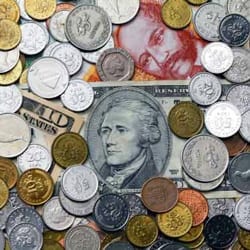Baker Institute international economics fellow Russell Green marks the 30th anniversary of the historic Plaza Accord with the blog below on the impact of the historic agreement and what it would take to duplicate its success.
An Oct. 1 Baker Institute conference will reunite some of the key players from the summit to discuss the lessons of the accord and its implications for present-day financial markets. The event is free and open to the public, but an RSVP is required. Click here to register for “Currency Policy Then and Now: 30th Anniversary of the Plaza Accord.”
Thirty years ago today, the financial leaders of the five leading economies of the time gathered in the Plaza Hotel, concerned about an excessively strong dollar. The coordinated effort to deflate the dollar that resulted from that meeting seems appealing again. The substantial run-up in the dollar over the past year has created tensions about competitive devaluations, and growing trade imbalances lurk around the corner. What would it take to achieve another Plaza Accord?
Concern about currency wars have been high since the U.S. announced QE3. Scrutiny subsequently shifted to Japan, and indeed the yen fell 20 percent against the dollar in the back half of last year. Most dollar strength since March has come against emerging economies. China has been the only country to resist depreciation, despite its surprising 3 percent fall last month. Korea on the other hand, has been intervening heavily to keep the won competitive against its neighbors. The downward pressure on the yuan poses a latent source of further dollar strength. If released, it would likely be followed by other Asian currencies, magnifying the impact on the dollar.
Raising the stakes of dollar strength is the return of interest in Congress for trade issues, most obviously in the bipartisan resistance to the trade authorization bill this spring. Ominously, the U.S. trade deficit–which has remained fairly stable at a sustainable 2.5 percent of GDP since the financial crisis–will likely begin to expand next year. Trade responds with a lag to exchange rate movements because it takes time to renegotiate contracts, find new suppliers, etc. The sharp drop in the dollar in 1985 did not move the dial on the trade balance until the end of 1987.
Growing alongside the trade deficit will come calls to protect U.S. industries. If the pressure begins to bite early enough, it may become an issue in the Presidential race next year. Perhaps it would be wise to act pre-emptively and collectively act to take the steam out of the dollar now, before another round of beggar-thy-neighbor currency policies or the forces of protectionism gain momentum.
The Plaza Accord looks like a good model. With the aid of Japan, Germany, France and the U.K., the U.S. engineered a decline of the dollar far beyond their expectations. It took a while, but U.S. trade eventually returned to balance in 1991.
It is easy to look at the state of international policy coordination today and immediately dismiss the idea that other countries would cooperate with another Accord. But the early 1980s had not been a particularly cooperative period either, with the U.S. mostly antagonizing its partners in the G-5. Germany and Japan were exporting powers for whom appreciation was certain to hurt. The Plaza Accord was a major surprise at the time.
Several factors played into the unlikely success of the Accord. The threat of protectionism was probably the biggest. Congress was farther down that road in 1985, with several aggressive bills in play, than they are today. So rather than being content with weak currencies, the Germans had tried unilaterally to prop up the mark for several years prior. Likewise, the Japanese were arguably the most enthusiastic participants in the Plaza Accord.
The importance of consensus has been pointed out by Ted Truman of the Peterson Institute for International Economics and a senior official at the Fed in the 1980s. By early 1985 policymakers worldwide were concerned about a bubble in the dollar that might burst with damaging consequences.
Another key factor was how sharp of a policy change this represented for the dollar. The Reagan Treasury had carried out a stridently hands-off policy towards the dollar during the first term. Markets also assumed the Fed would go along by at least ceasing to raise interest rates.
The dynamics have changed, with new major economies and much weaker growth prospects, yet the experiment in policy coordination launched with the Plaza Accord still echoes loudly. Today’s strong dollar has perhaps not gone far enough either to embolden protectionism or to galvanize resolve to act. When looking at likely differentials in growth and interest rates in the medium term, however, it is not hard to imagine the dollar rising further.
Perhaps the greatest reason to doubt that another Plaza Accord could happen comes from the lesson central banks learned from that period. The Accord’s success inspired years of active currency management, which the Fed and the Bank of Japan came to believe disrupted their pursuit of domestic economic objectives.
To be consistent with domestic monetary objectives, an attempt to weaken the dollar today would require the ECB and Bank of Japan to be tightening interest rates, and the U.S. to be cutting. So if another Plaza Accord does come together, it would share one key element of success with thirty years ago. It would be a total surprise.
Russell Green is the Will Clayton fellow in International Economics. His research interests include developing policy insights for emerging economies to manage cross-border spillovers from increasingly interconnected markets and exploring the effect of harmonized international bank regulations on unique domestic financial institutions.
